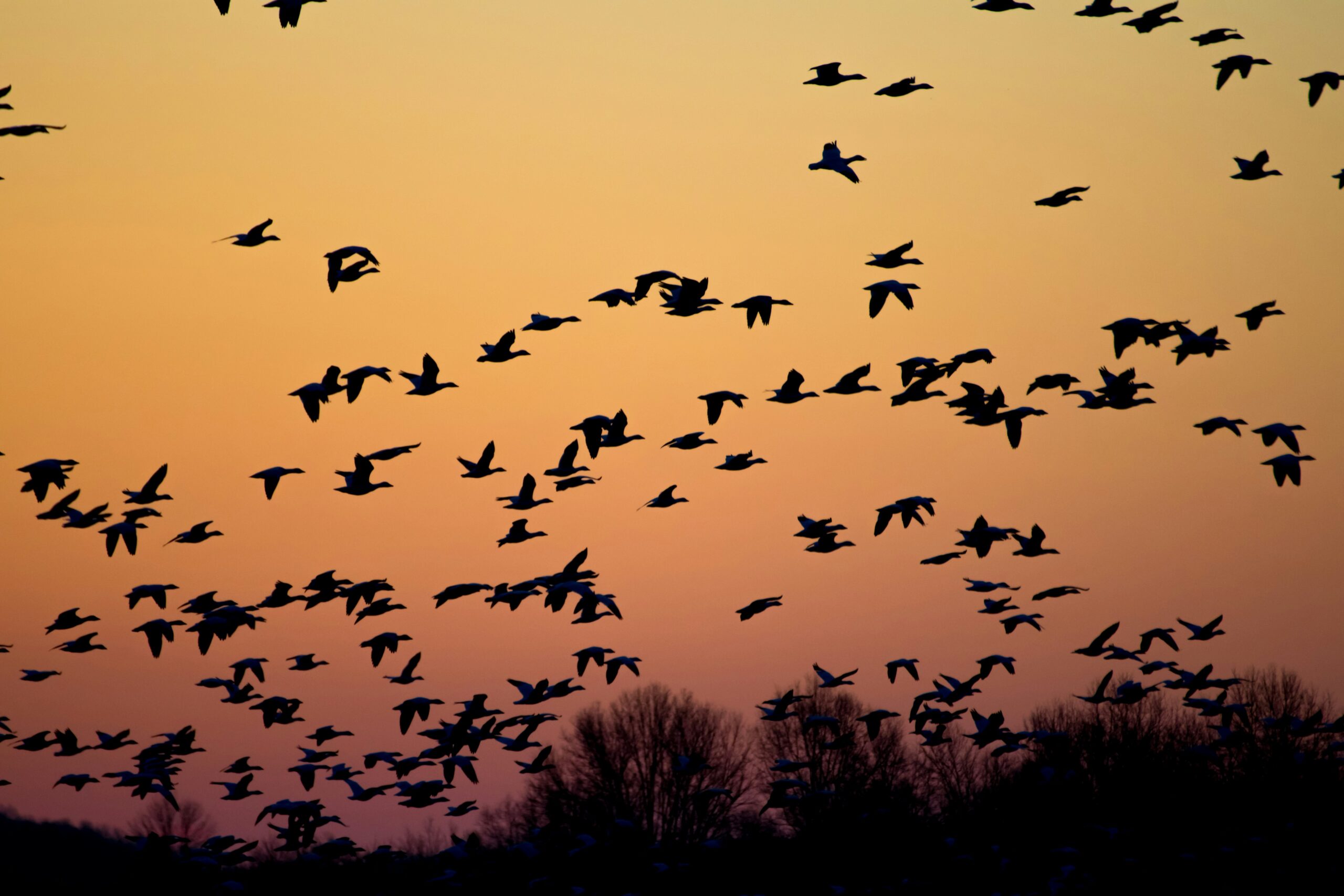Duck Migration Calendar
Greer Smith
May 3, 2024

With this duck migration blog, you get a fascinating glimpse into the annual journeys undertaken by various duck species. These migrations, driven by weather patterns, food availability, and reproductive needs, dictate breeding and survival. Monitoring migration patterns benefits birdwatchers, researchers, and conservationists. The process aids in the study and support of these migratory birds. The information you gather will play a role in conservation efforts and help maintain ecological balance.
Each viewing is an indicator of the health of our planet’s ecosystems. Additionally, this blog is a valuable educational resource, enhancing wildlife appreciation and awareness among schools, nature centers, and environmental organizations.
Please note: We recognize the migration patterns, the diverse populations of individual waterfowl species, and the extensive distances they travel to breed and inhabit throughout the year. Given this variability, our blog for kids to explore different species is intended for fun and may not always reflect the precise movements of North American waterfowl.
Possible Migration Patterns For Wildlife Observation
Duck migration, a phenomenon as ancient as it is awe-inspiring, follows specific routes that vary from species to species. These journeys are influenced by environmental conditions, leading to patterns that can shift based on factors like drought and severe weather patterns.
Observers can note the seasonality of these migrations, with departures from breeding grounds and arrivals at wintering sites marked by the calendar. If you wish to witness these natural events, national parks, wildlife refuges, and wetlands are prime locations.
During waterfowl migration, ducks exhibit fascinating behaviors such as forming large flocks and flying in V-formations to conserve energy. However, we must recognize that changing conditions may alter traditional timings, routes, and stopover sites for ducks and geese. Waterfowl are dynamic creatures, and migratory shifts can significantly impact wildlife observation.
| Duck Breed | Month | Destination |
| Common Goldeneye, Surf Scoter, Northern Pintail, Ruddy Duck | January |
Common Goldeneye: Great Lakes, Oregon, California Surf Scoter: Great Lakes Northern Pintail: Great Lakes Ruddy Duck: Great Lakes |
| Mallards, Common Goldeneye, Surf Scoter, Northern Pintail, Ruddy Duck | February |
Mallards: Northern US and Canada, centraal U.S Common Goldeneye: Great Lakes, Oregon, California Surf Scoter: Great Lakes Northern Pintail: Great Lakes, central U.S, Gulf Coast Ruddy Duck: Great Lakes, Western Canada |
| Mallards, Canvasbacks, Cinnamon Teal, Wood Ducks, Ruddy Duck | March |
Mallards: Northern US and Canada, central U.S Canvasbacks: Alaska, Canada, Northern US, Prairie Pothole Region Cinnamon Teal: Western United States, Great Salt Lake, San Luis Valley Wood Ducks: Pacific Northwest, East of the Rocky Mountains Ruddy Duck: Great Lakes, Western Canada |
| Blue-Winged Teal, Canvasbacks, Cinnamon Teal, Ruddy Duck | April |
Blue-Winged Teal: Alaska, Prairie Pothole Region, Southern High Plains Canvasbacks: Alaska, Canada, Northern US, Prairie Pothole Region Cinnamon Teal: Western United States, Great Salt Lake, San Luis Valley Ruddy Duck: Western Canada |
| Blue-Winged Teal, Cinnamon Teal, Northern Pintails | May |
Blue-Winged Teal: Alaska, Prairie Pothole Region, Southern High Plains Cinnamon Teal: Western United States, Great Salt Lake, San Luis Valley Northern Pintails: Alaska, Canadian Arctic, Central United States, PPR |
| Northern Pintails | June | Northern Pintails: Alaska, Canadian Arctic,, Central United States, PPR, Sacramento Valley |
| Mallards | July | Mallards PPR, Great Lakes |
| Mallards, Blue-Winged Teal, Cinnamon Teal, Northern Shoveler | August |
Mallards: PPR, Great Lakes, Gulf Coast, Southern US, Mexico Blue-Winged Teal: Southern United States, Mexico, Central America Cinnamon Teal: Mexico, Central America Northern Shoveler: Southern US, California, Louisiana, Texas, Mexico |
| Mallards, Blue-winged Teal, Cinnamon Teal, Wood Ducks, Northern Shoveler, Ruddy Ducks | September |
Mallards: Outer Banks, NC, Gulf Coast, Southern US, Mexico, PPR, California Blue-Winged Teal: Southern United States, Mexico, Central America Cinnamon Teal: Mexico, Central America Wood Ducks: Georgia, Texas Northern Shoveler: Southern US, California, Louisiana, Texas, Mexico Ruddy Ducks: US & Mexico |
| Canvasbacks, Mallards, American Black Ducks, Northern Pintails, Green-Winged Teal, American Widgeon, Gadwall, Wood Ducks, Northern Shoveler, Ruddy Ducks | October |
Canvasbacks: San Francisco Bay, Central Valley, Gulf Coast, Atlantic Coast, Northern Mexico Mallards: Outer Banks, NC, Gulf Coast, Southern US, Mexico American Black Ducks: Long Island to the Outer Banks, NC Northern Pintails: Outer Banks, NC Green-Winged Teal: Outer Banks, NC American Widgeon: Outer Banks, NC Gadwall: Outer Banks, NC Wood Ducks: Georgia, Texas Northern Shoveler: Southern US, California, Louisiana, Texas, Mexico Ruddy Ducks: US & Mexico |
| Canvasbacks, Mallards, American Black Ducks, Northern Pintails, Green-Winged Teal, American Widgeon, Gadwall | November |
Canvasbacks: San Francisco Bay, Central Valley, Gulf Coast, Atlantic Coast, Northern Mexico Mallards: Outer Banks, NC, Gulf Coast, Southern US, Mexico American Black Ducks: Long Island to the Outer Banks, NC Northern Pintails: Outer Banks, NC Green-Winged Teal: Outer Banks, NC American Widgeon: Outer Banks, NC Gadwall: Outer Banks, NC |
| Mallards, Common Goldeneye, Surf Scoter, Northern Pintail, Ruddy Duck | December |
Mallards: Outer Banks, NC, Gulf Coast, Southern US, Mexico Common Goldeneye: Great Lakes, Oregon, California Surf Scoter: Great Lakes Northern Pintail: Great Lakes Ruddy Duck: Great Lakes |
